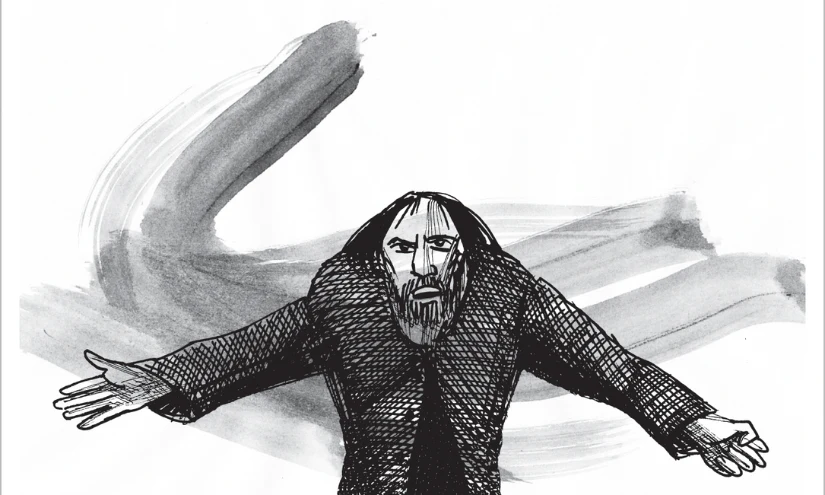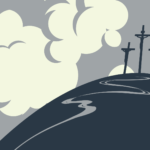Review: The Fearless Benjamin Lay, Marcus Rediker, Verso
Prophet Against Slavery: Benjamin Lay, a Graphic Novel, Lester, Buhle and Rediker, Verso
He was an abolitionist decades before the abolitionist movement got going. He was a vegetarian and almost-vegan, centuries before such things were fashionable. He was a dwarf but never let his physical stature impede his passion, and argued, ahead of his time, that the physical does not reflect upon mental capability. He was also a Quaker, but the Quakers (otherwise known as the Society of Friends) tried to silence him for his insistence on living out their ideals.
Benjamin Lay was born in the late 1600s, in Essex, a centre of the textile industry, where he learnt to sew, later using that skill for making his own clothes. He was a glove-maker but later decided that the sixth commandment applied also to animals. He was largely self-educated, a voracious devourer of books. In his youth he was a shepherd and loved the shepherd imagery of the Bible, describing people as lambs but slave-owners as wolves.
Like other adventurers, the sea called. Being a sailor generated a familiarity with a simple lifestyle, as well as a cosmopolitan outlook. Through his travels, he saw everyone as equal, regardless of class or race. He used the word ‘barbarian’, which the English would routinely apply to non-English peoples, only in relation to slave-owners.
Lay led a peripatetic life, in London, Essex, Barbados and the American colonies. He and his wife Sarah opened a shop in Barbados, where there was a strong Quaker community, possibly to escape tension the always-outspoken Lay had caused in Quaker communities in England. In Barbados, where slaves outnumbered the free ten to one, they witnessed the horrors of slavery for sugar production. Vocal in opposition to the practice, the Lays left Barbados before they were run out by angry whites. Lay later wrote that they were traumatised by the inhumane treatment of slaves.
In Philadelphia Lay ran a bookshop (Sarah travelled, preaching). They found a strong community of Friends, many of whom were prosperous, with fine houses. But some were also slave-owners, which got Lay fired up again. He caused trouble wherever he went, criticising slavery and reprimanding ministers who didn’t live up to their calling. He could see the violence that was associated with the accumulation of property, and the greed that simmered underneath the veneer of civility.
In his day, a minority were abolitionists, but most saw slavery as somewhat in the natural order of things. Lay, instead, would refuse to eat with slave-holders, and would heckle any slave-holder who rose to speak in Quaker meetings. In return, Lay was thrown out of numerous meeting houses, even, on one occasion, when he didn’t say a word. Quakers valued politeness, but they also valued truth, and Lay was determined to speak the truth of injustice in their midst, describing himself as David confronting Goliath.
He was determined to make his fellow Quakers live up to biblical ideals. He was particularly influenced by the Book of Revelation, where the militant Lamb confronts the forces of evil. The imagery in Revelation fitted his characterisation of the devilish slave trade, the slave-owners (subjects of Satan) and the falseness of those purporting to be Christian but under the thrall of the Beast.
He was also influenced by the radicals of the English Revolution and they way they used public stunts. Lay would engage in witty public debate with opponents, who inevitably underestimated him to their detriment. On one occasion he took a hammer to a tea-set, in front of horrified onlookers, in protest at the unfairness of the global tea trade. In 1738 Lay went to a yearly meeting of Quakers, lectured the assembly about equality, then drew a sword from beneath his cloak and stabbed a book that had fake blood inside it, spattering the audience. He repeated such public theatre many times, in the streets and in meetings.
Soon after, his friend Benjamin Franklin published Lay’s chaotic but passionate book All Slave-keepers that Keep the Innocent in Bondage, Apostates. Full of biblical quotes and allusions, he argued in it that all are created equal and to continue modern slavery is to court damnation. He noted that the continuation of slavery was largely due to profit, and that opposition to slavery was suppressed by the wealthy. Additionally, he argued that it was rank hypocrisy to be a Quaker pacifist and a slave-owner. Predictably, he attracted the denouncement of the powerful.
Marcus Rediker emphasises Lay’s links to the ideals of the English revolutionaries – the likes of the Diggers and Levellers, who attempted to put biblical principles into radical practice. Rediker writes about how the Greek Cynics, uncompromising in philosophy and their rejection of social graces, influenced Lay, and puts Lay into the context of the abolitionist movement that came largely after Lay. He also explains Lay’s lack of fame, attributing it to prejudice over his physical stature and class and the way fellow Quakers tried to silence and distance themselves from him. (Contemporary Friends, proud of their antislavery activism, are redressing that.)
Rediker argues for Lay as a pioneering figure who deserves wide recognition. To that end, he has also produced, with illustrator David Lester, a graphic novel of Lay’s life, with illustrations in a striking, scratchy style that dramatises Lay’s confrontations with the powerful.
In the last decades of his life, after his wife’s death, Lay practised his Pacifist lifestyle, living in a modified cave, spinning cloth and making clothes, eating only vegetables and fruit, and reading. Before he died in his late seventies, he saw vindication of his Jeremiah-like activism, when Quakers banned slave-holders from their membership (being the first group to do so).
Nick Mattiske blogs on books at coburgreviewofbooks.wordpress.com and is the illustrator of Thoughts That Feel So Big.












